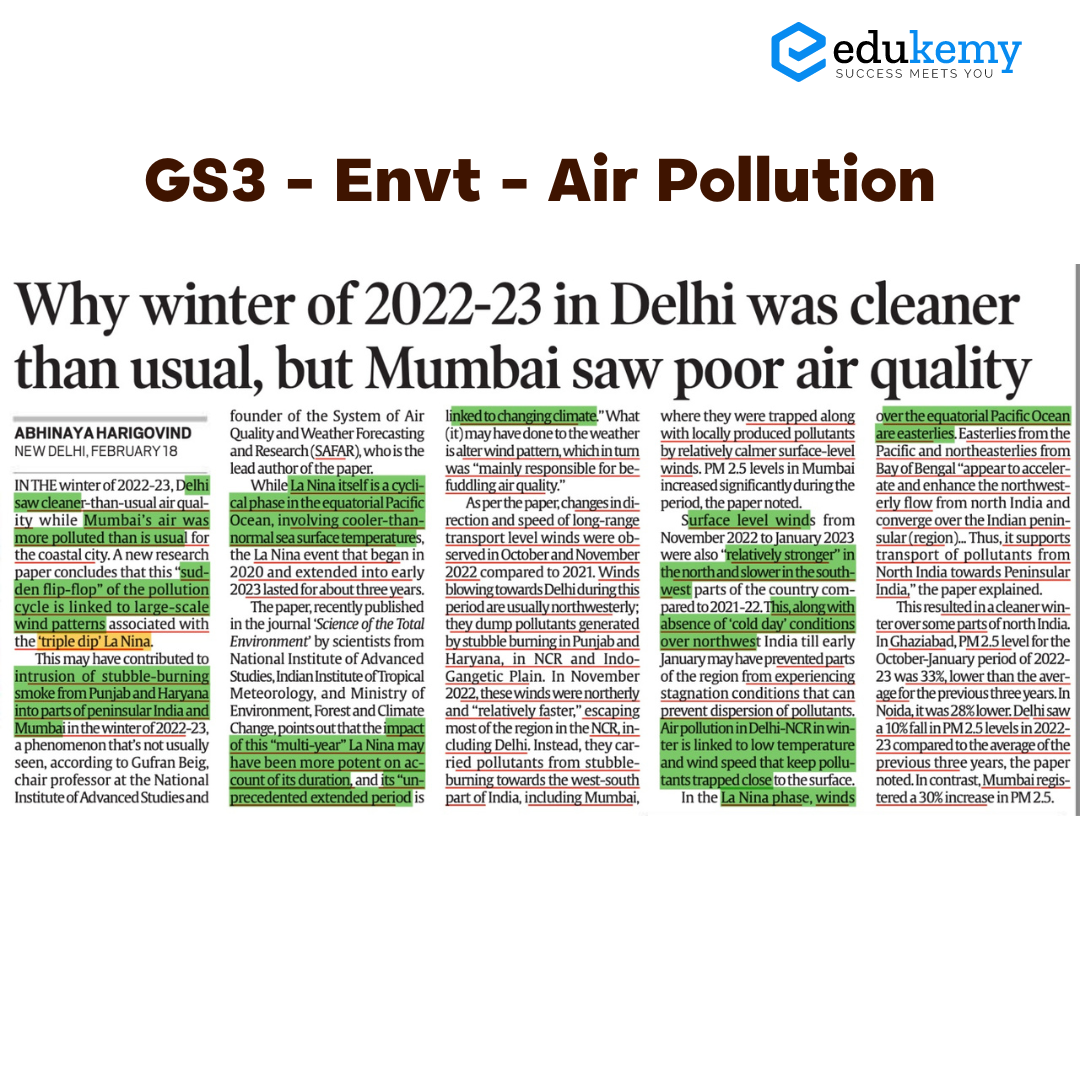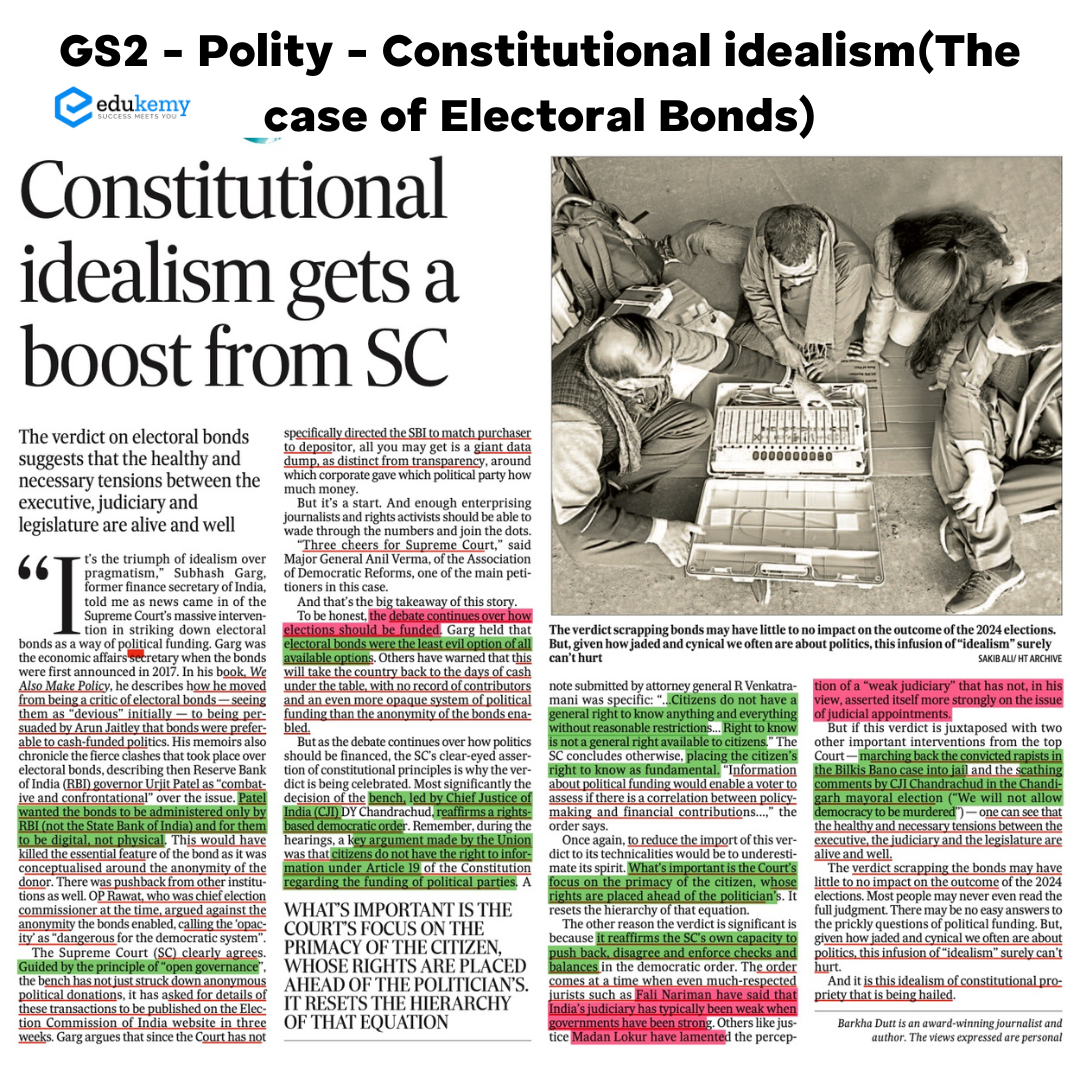Thursday, 22nd February 2024
Daily News Paper Snippets - 22nd February 2024

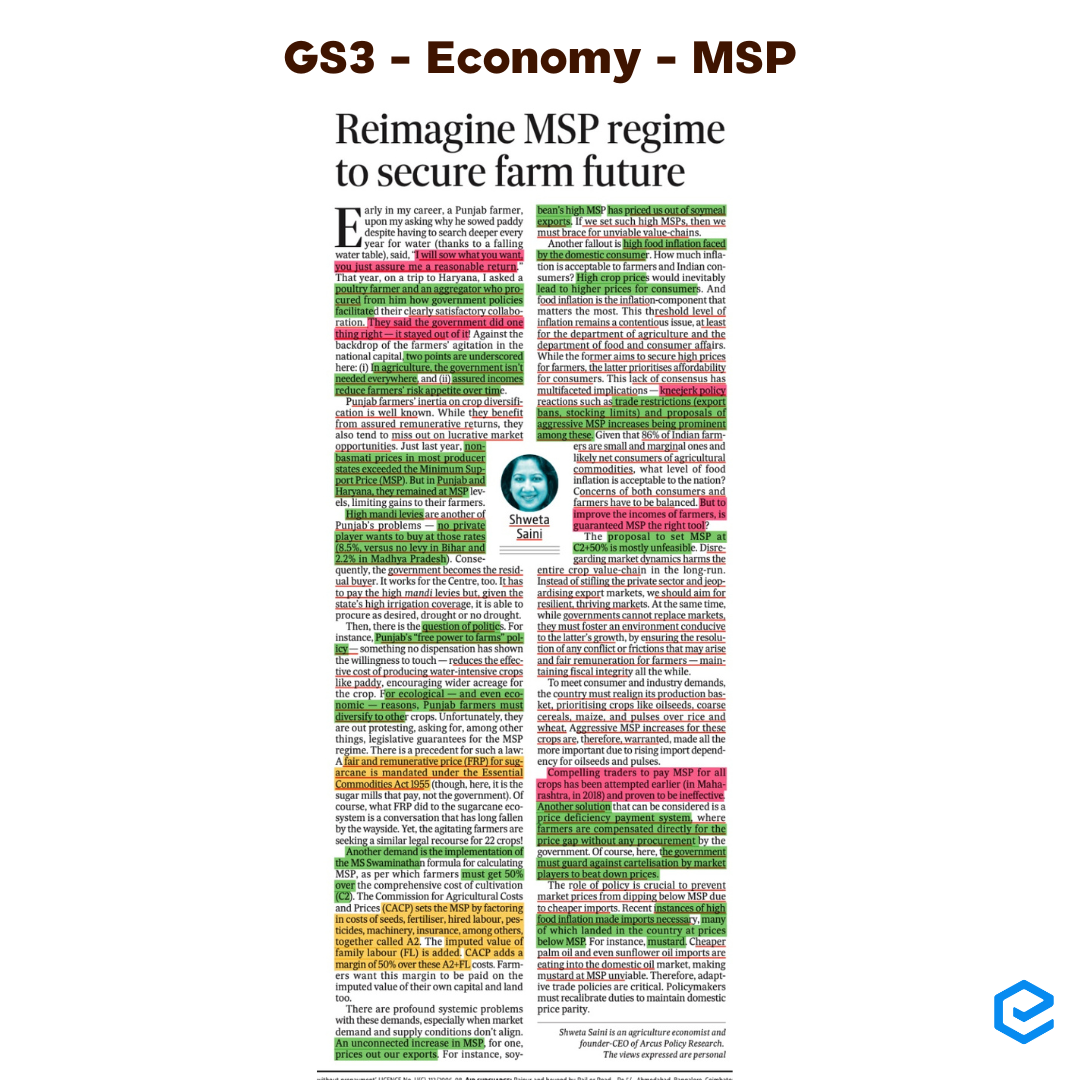
India's Industrial Sector
In News: Even with a rapid rebound post-pandemic, India grapples with 'premature deindustrialization,' intensifying inequality as the advantages of swift growth disproportionately benefit a small minority, further widening existing disparities.

Understanding Premature Deindustrialization
- Definition
- Premature Deindustrialization is a phenomenon where an economy's manufacturing sector experiences an early slowdown in growth on its development trajectory. This concept was introduced by Turkish Economist Dani Rodrik in 2015.
- Economic Development Transitions
- Economists typically envision economic development as a progression from agriculture to manufacturing and then to services. However, some economies may undergo premature shifts to the services sector, impeding the growth of manufacturing.
Current State of India's Industrial Sector
- Historical Overview
- Throughout history, India's industrialization progress has been suboptimal, with manufacturing contributing less than 20% to output and employment, except during the 2003-2008 'Dream Run.'
- Despite 1991 LPG reforms aiming for labor-intensive industrialization, this trend persisted.
- Factors Influencing Stagnant Industrialization
- Inadequate R&D Investment
- Limited research and development investment hinder innovation and technological advancement, affecting global competitiveness.
- Corruption and Red Tape
- Rampant corruption and bureaucratic inefficiencies in obtaining permits create obstacles and increase the cost of doing business.
- Informal Economy Dominance
- Competition from the informal economy creates an uneven playing field, impacting formal industrial enterprises' growth prospects.
- Skill Mismatch
- Discrepancies between demanded and possessed skills contribute to underemployment and inefficiencies in the industrial sector.
- Supply Chain Vulnerabilities
- Dependency on imported raw materials makes Indian industries susceptible to global supply chain disruptions.
- Inadequate R&D Investment
Strategies to Revitalize the Industrial Sector
- Unconventional Approach
- India requires an unconventional approach, prioritizing high-skill services, especially in IT, to stimulate manufacturing growth, contrary to the traditional view.
- Arguments for and Against Service Sector's Impact on Manufacturing
- Arguments in Favour
- Increased Consumer Demand
- A thriving service sector can generate consumer demand for manufactured goods, particularly in infrastructure development.
- Supply Chain Integration
- Services like logistics can enhance supply chain efficiency, reducing costs for the manufacturing sector.
- Complementary Expertise
- Service industries can provide expertise in design and branding, offering valuable insights for manufacturing optimization.
- Increased Consumer Demand
- Arguments Against
- Deepening Inequality
- The service sector's demand for highly skilled workers may deepen inequality, creating disparities in earnings.
- Limited Direct Linkages
- Direct linkages between services and manufacturing remain limited, potentially neglecting basic industries.
- Neglect of Basic Industries
- Prioritizing the service sector may lead to neglect of critical infrastructure for basic small-scale industries, hindering long-term competitiveness.
- Deepening Inequality
- Arguments in Favour
Future Strategies for Industrial Growth
- Shifting Focus to Deep Industrialization
- Emphasize adoption of Industry 4.0 technologies for smart manufacturing processes.
- Infrastructure Development
- Improve power generation, transportation networks, and high-speed internet access.
- Rural Industrialization Models
- Develop innovative models for rural industrialization, empowering local artisans and entrepreneurs.
- Bio-based Manufacturing
- Explore India's potential in bio-based manufacturing, utilizing renewable feedstocks and biotechnological processes.
|
UPSC Previous Year Questions Prelims (2015) Q. In the ‘Index of Eight Core Industries’, which one of the following is given the highest weight? (a) Coal production Ans: (b) Mains (2017) Q.1 “Industrial growth rate has lagged behind in the overall growth of Gross-Domestic-Product (GDP) in the post-reform period” Give reasons. How far are the recent changes in Industrial Policy capable of increasing the industrial growth rate? Mains (2014) Q.2 Normally countries shift from agriculture to industry and then later to services, but India shifted directly from agriculture to services. What are the reasons for the huge growth of services vis-a-vis the industry in the country? Can India become a developed country without a strong industrial base? |
Source: TH
Maintenance Entitlement for Divorced Muslim Women under Section 125 of the CrPC
In News: The Supreme Court has opted to scrutinize whether a divorced Muslim woman has the right to seek maintenance from her ex-husband under Section 125 of the Criminal Procedure Code (CrPC).
Muslim Women (Protection of Rights on Divorce) Act, 1986
- Introduction
- The 1986 Act is a law specific to the Muslim community, establishing a procedure for Muslim women to seek maintenance during divorce.
- Its enactment was prompted by the Supreme Court's 1985 decision in Mohd. Ahmad Khan v. Shah Bano Begum, which affirmed a Muslim woman's right to maintenance under Section 125 of the CrPC.
- Objective and Context
- The Act was introduced to address concerns surrounding the perceived challenge to religious personal laws posed by the Shah Bano case.
- It specifically focuses on maintenance provisions for divorced Muslim women.
Key Provisions of the 1986 Act
- Maintenance during Iddat
- Section 3 ensures maintenance payment to a divorced Muslim woman during the iddat period, typically three months after divorce.
- The amount is stipulated to be equivalent to the mahr or dowry given to her during or after marriage.
- Post Iddat Maintenance
- After the iddat period, if the woman remains unmarried and financially incapable, she can seek maintenance from a first-class magistrate.
Section 125 of the Criminal Procedure Code (CrPC)
- Secular Maintenance Law
- Section 125 of CrPC is a secular provision facilitating maintenance for wives, children, or parents unable to sustain themselves.
- It aims to prevent situations of vagrancy and poverty, providing legal recourse for financial support.
- Categories Eligible for Support
- Individuals falling within specified categories, such as spouses or children, can claim financial assistance under this section.
- Preventing Vulnerability
- Section 125 serves to prevent vulnerability by offering monetary support to those in need, avoiding destitution and poverty.
Judicial Precedents and Interpretations
- Allahabad High Court Decisions
- The Allahabad High Court has consistently affirmed the right of divorced Muslim women to claim maintenance under Section 125 of CrPC post the iddat period, as long as remarriage has not occurred.
- Case Examples
- In Mujeeb Rahiman v. Thasleena (2022), the Kerala High Court maintained that a divorced Muslim woman can seek maintenance under Section 125 until relief is obtained under Section 3 of the 1986 Act.
- Noushad Flourish v. Akhila Noushad (2023) clarified that a Muslim wife, who has obtained a divorce through khula, cannot claim maintenance under Section 125 of CrPC from her husband.
Source: TH
Asia-Pacific SDG Progress Report 2024
In News: UNESCAP's recently published Asia-Pacific SDG Progress Report 2024 spotlights success stories, trends, and challenges in the region's journey toward achieving the Sustainable Development Goals (SDGs).
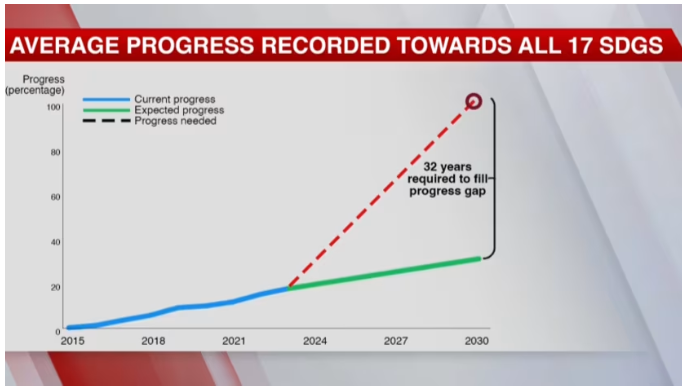
Asia and the Pacific SDG Progress Report: Overview
- Annual Flagship Publication
- The Asia and the Pacific SDG Progress Report stands as a key annual publication by the United Nations ESCAP, offering a comprehensive view of the region's progress towards Sustainable Development Goals (SDGs). It serves as a foundational resource guiding various activities conducted by ESCAP and its partners.
- Prioritizing Data Availability
- The report emphasizes the importance of enhancing data availability for SDG indicators, particularly focusing on vulnerable population groups. This approach aims to shape more inclusive and equitable development strategies.
Key Report Highlights
- Delayed Overall Progress
- Progress on the 17 SDGs remains uneven and insufficient across diverse population segments and within the region's five subregions.
- The projected achievement of all SDGs is delayed to 2062, marking a significant 32-year lag from the target year of 2030.
- Limited Progress on Measurable Targets
- Only 11% of the 116 measurable SDG targets are on track, with the region expected to achieve just one-third of the required progress by 2030 at the current pace.
- Climate Action Challenges
- SDG 13 (Climate Action) lags critically behind, emphasizing the need to incorporate climate action into national policies to address climate-related challenges.
- Data Gaps Hindering Monitoring
- Approximately 67% of the 169 SDG targets in the region are currently not measurable.
- Data gaps persist for 53 targets, including climate-related ones, hindering effective progress monitoring.
- Gender Inequality Challenges
- Despite progress in school enrolment, women and girls face challenges in accessing education and employment opportunities.
- Gender disparities persist in enrolment rates, literacy, and employment, impacting overall development.
- Interconnectedness of Goals
- Limited progress is observed in goals related to hunger, health, clean water, affordable and clean energy, and sustainable cities, with challenges connected to climate change.
- Global Risks Warning
- Climate change and extreme weather events are highlighted as severe global risks, underscoring the importance of addressing climate action for SDG targets.
- National Success Stories
- Positive examples include legislative changes in the Philippines supporting children with disabilities and digital training programs in Vietnam fostering youth employment.
Recommendations from the Report
- Addressing Inequalities
- Urgent measures are needed to tackle inequalities affecting marginalized groups, including women, girls, rural populations, and the urban poor.
- Sustainable Infrastructure Investment
- Significant increases in investment in sustainable infrastructure and renewable energy are crucial to address climate change challenges and achieve SDGs.
India's SDG Progress: Report Insights
- Overall Improvement
- India's SDG score improved by 6 points, rising from 60 in 2019 to 66 in 2020–21.
- Notable Achievements
- Goal 6 (Clean Water and Sanitation) and Goal 7 (Affordable and Clean Energy) showcased notable achievements, with composite goal scores of 83 and 92, respectively.
United Nations Economic and Social Commission for Asia and the Pacific (UNESCAP)
- Regional Development Arm
- UNESCAP is the regional development arm of the United Nations for the Asia-Pacific region.
- Member States and Objectives
- Comprising 53 Member States and 9 Associate Members, UNESCAP aims to address regional challenges through projects, technical assistance, and capacity building.
- Establishment and Headquarters
- Established in 1947, UNESCAP is headquartered in Bangkok, Thailand.
|
UPSC Previous Year Questions Prelims (2016) Q. Consider the following statements:
Which of the statements given above is/are correct? (a) 1 only Ans: (b) Exp:
Mains (2018) Q. Access to affordable, reliable, sustainable and modern energy is the sine qua non to achieve Sustainable Development Goals (SDGs).” Comment on the progress made in India in this regard. Mains (2020) Q. National Education Policy 2020 isin conformity with the Sustainable Development Goal-4 (2030). It intends to restructure and reorient education system in India. Critically examine the statement. |
Source: DTE
National Commission for Scheduled Castes
In News: The Vice-Chairman (Chairman In-charge) presented the Annual Report 2022-23 of the National Commission of Schedule Caste to the President of India.
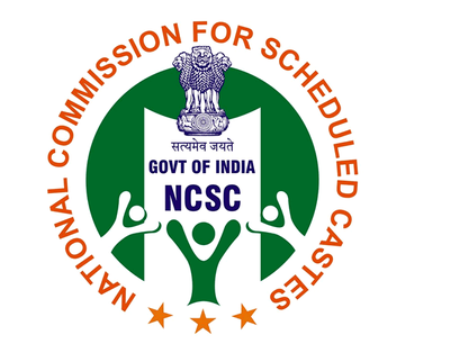
National Commission for Scheduled Castes (NCSC): Overview
- Establishment and Purpose
- The NCSC, a Constitutional Body, was established to safeguard Scheduled Castes (SCs) against exploitation and promote their social, educational, economic, and cultural interests.
- Historical Evolution
- Initially, a Special Officer (Commissioner for Scheduled Castes and Scheduled Tribes) was appointed under Article 338.
- The 65th Constitutional Amendment Act, 1990 replaced the one-member system with the multi-member National Commission for SCs and STs.
- The 89th Constitutional Amendment Act, 2003 led to the creation of separate Commissions for SCs and STs.
- Composition
- The NCSC consists of a Chairperson, Vice-Chairperson, and three additional Members, appointed by the President.
- Functions
- Investigate and monitor matters related to constitutional and legal safeguards for SCs.
- Inquire into specific complaints regarding the deprivation of SCs' rights.
- Participate in and advise on the socio-economic development planning for SCs.
- Evaluate progress and present reports to the President.
- Make recommendations for effective implementation of safeguards and development measures.
- Power and Authority
- The Commission can regulate its own procedure and possesses powers akin to a civil court during investigations.
- Governments must consult the NCSC on major policy matters affecting SCs.
- Constitutional Provisions for SC Upliftment
- Article 15: Addresses caste-based discrimination, emphasizing SC protection and upliftment.
- Article 17: Abolishes Untouchability, promoting equality and dignity.
- Article 46: Directs the State to promote educational and economic interests, protecting from social injustice.
- Article 243D (4) and Article 243T (4): Mandates seat reservations for SCs in Panchayats and Municipalities.
- Article 330 and Article 332: Reserves seats for SCs in Lok Sabha and State legislative assemblies.
- Challenges
- Criticisms include bureaucratic hurdles, political interference, delays in addressing complaints, and inadequate SC community representation.
- Recommendations
- Enhance NCSC autonomy and allocate increased resources.
- Implement proactive measures to address systemic discrimination.
- Strengthen outreach programs and ensure transparency.
- Foster collaboration with civil society organizations for effective safeguarding of SC rights.
|
UPSC Previous Year Questions Prelims (2016) Q. With reference to ‘Stand Up India Scheme’, which of the following statements is/are correct?
Select the correct answer using the code given below: (a) 1 only Ans: (c)
Mains (2017) Q.1 What are the two major legal initiatives by the State since Independence addressing discrimination against Scheduled Tribes (STs)? Mains (2020) Q.2 Has caste lost its relevance in understanding the multi-cultural Indian Society? Elaborate your answer with illustrations. Mains (2018) Q.3 “Caste system is assuming new identities and associational forms. Hence caste system cannot be eradicated in India.” Comment. Mains (2015) Q.4 Debate the issue of whether and how contemporary movements for assertion of Dalit identity work towards annihilation of caste. |
Source: PIB
Kapilvastu Relics
In News: The National Museum currently houses four bone fragments of Lord Buddha, commonly referred to as Kapilvastu Relics. These relics will be transported to Thailand after approximately three decades.
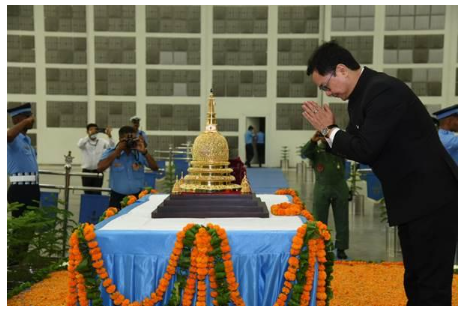
About Kapilvastu Relics
- The Kapilvastu relics, discovered in Piprahwa, Uttar Pradesh, were excavated from the ancient city of Kapilavastu.
- In 1898, British colonial engineer William Claxton Peppé discovered an inscribed casket at the stupa site in Piprahwa. The casket's lid inscription refers to the relics of Buddha and his community, the Sakya.
- According to Buddhist beliefs, Buddha attained salvation at the age of 80 in Uttar Pradesh's Kushinagar district.
- The Mallas of Kushinagar conducted funeral ceremonies for Buddha and cremated his body with rituals befitting a universal king.
- After the cremation, Buddha's relics were collected from the funeral pyre and divided into eight shares. These were distributed among various groups, including the Ajathsatrus of Magadha, the Licchavis of Vaishali, the Sakyas of Kapilavastu, and others.
- The purpose of distributing the relics was to erect stupas over them. Two additional stupas were built, one over the urn containing the relics and the other over the embers from the funeral pyre.
- These stupas, known as Saririkastupas, are considered the earliest surviving Buddhist shrines, erected over the bodily relics of Buddha.
- Ashoka, a devoted follower of Buddhism around 272–232 BCE, played a significant role. He opened seven of the eight stupas, collecting a major portion of the relics. Ashoka then enshrined these relics within numerous stupas (84000 in total) that he built, aiming to popularize Buddhism and spread dharma.
Source: IE
Shompen Tribe
In News: India's president recently conducted a brief visit to an island slated for a multi-billion-dollar development, a move criticized by experts who caution that it could pose a significant threat to the indigenous Shompen tribe residing there.
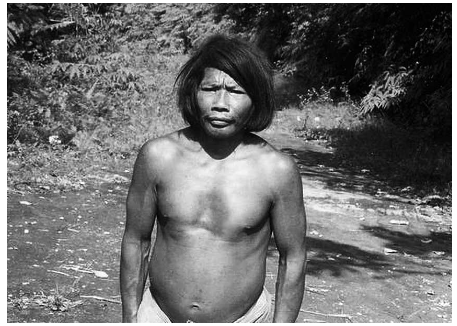
Shompen Tribe: A Glimpse into an Isolated Community
- Isolation and Habitat
- The Shompen Tribe is recognized as one of the most isolated communities globally.
- They inhabit the dense tropical rainforest of the Great Nicobar Island within the Andaman and Nicobar group of Islands.
- Limited Study and Population
- Designated as one of the least studied Particularly Vulnerable Tribal Groups (PVTGs) in India.
- The 2011 Census estimates the Shompen population at 229, but the precise count remains unknown.
- Uncontacted Lifestyle
- The majority of the Shompen people remain uncontacted, deliberately avoiding interactions with outsiders.
- They organize themselves into small groups, with territories identified by the criss-crossing rivers in the rainforest.
- Semi-Nomadic Hunter-Gatherers
- Engaged in semi-nomadic lifestyles, relying on hunting, gathering, fishing, and rudimentary horticultural activities for livelihood.
- Traditional hunting includes wild pig, python, monitor lizard, crocodile, and sea turtle.
- Dietary Staples and Language
- Primary food source is the pandanus fruit, locally known as larop.
- The Shompen speak their own language with multiple dialects, leading to limited mutual comprehension among different groups.
- Physical Features and Family Structure
- Members display short to medium stature, round or nearly broad head shape, narrow nose, and Mongoloid features such as light brown to yellow-brown skin and oblique eye features.
- Shompen families adhere to a nuclear structure, consisting of a husband, wife, and unmarried children.
- Social Structure and Marriage Practices
- The eldest male member of a Shompen family holds authority, overseeing the activities of women and children.
- While monogamy is the general norm, polygamy is also permitted within the Shompen community.
Source: BBC
Section 91 of the Code of Criminal Procedure (CrPC)
In News: The Supreme Court recently noted that courts cannot use Section 91 of the Code of Criminal Procedure (Cr.P.C) to compel the production of documents at the accused's request during the framing of charges.
Section 91 of the Code of Criminal Procedure (CrPC): Unveiling Legal Powers for Document Production
- Empowerment of the Court
- Section 91 of the CrPC authorizes the court to issue summons or written orders for the production of essential documents or materials in the context of investigations, inquiries, trials, or other legal proceedings.
- Court's Authority for Document Production
- The court, under this section, can summon any person possessing necessary documents or materials, directing them to produce the required items if it deems it necessary or desirable for the administration of justice.
- Purpose of Section 91
- Ensures the availability of relevant evidence and materials during legal proceedings.
- Facilitates a fair and just resolution of cases by presenting necessary evidence before the court.
- Production of Documents
- Documents or materials can be presented in their original form or as certified copies, as specified in the summons or written order.
- Compliance with Section 91 Order
- The recipient of the summons must comply and produce the required document or material as directed.
- Exclusions from Section 91
- Does not cover items listed under Sections 123 and 124 of the Indian Evidence Act, 1872, or the Bankers Books Evidence Act, 1891.
- Excludes documents in the custody of postal or telegraph authorities, such as letters, postcards, telegrams, or parcels.
- Information Requirement for Summons
- The court needs to be informed of the person in possession of the document; otherwise, the summons application will not be entertained.
- Exclusion of Accused Persons
- The term 'person' in Section 91 does not encompass an accused person undergoing trial.
- Protocols and Precautions
- Police officers and courts must adhere to specific protocols when issuing and executing summonses under Section 91 CrPC.
- Adherence to Sections 123 and 124 of the Indian Evidence Act (1872) to protect the confidentiality and privilege of specific documents.
- Provision of a fair amount of time and an opportunity for compliance to the summoned individual is essential.
Source: LL
Model Code of Conduct (MCC) - Edukemy Current Affairs
In News: As the general election dates, triggering the Model Code of Conduct (MCC), are anticipated within a month, an Indian delegation is poised to depart for London to finalize the free trade agreement with the UK.
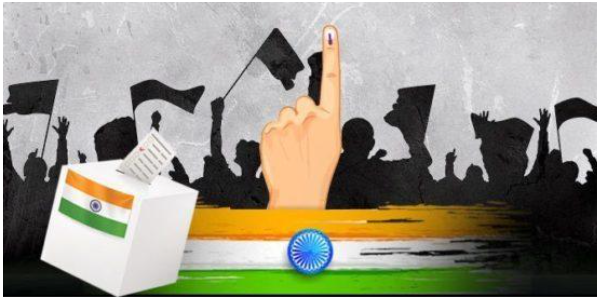
Model Code of Conduct (MCC): Regulating Election Conduct
- Introduction
- The MCC serves as a set of guidelines designed to regulate the behavior of political parties and candidates during elections.
- Voluntarily agreed upon by political entities, it aims to ensure free and fair polling conducted by the Election Commission of India (ECI).
- Structure of MCC
- Divided into eight parts, covering various aspects of electioneering, publication of advertisements, and conduct during the electoral process.
- Voluntary Agreement
- Political parties and candidates voluntarily agree to adhere to the MCC guidelines.
- Enforcement by ECI
- The ECI, under Article 324 of the Constitution of India, oversees the adherence to MCC by political parties in power and contesting candidates.
- Salient Features
- Outlines the conduct of political parties and candidates during electioneering, meetings, processions, poll day activities, and functioning of the party in power.
- Preventing Misuse of Official Machinery
- MCC ensures that official machinery is not misused for electoral purposes.
- Prevention of Offenses and Malpractices
- Aims to prevent electoral offenses, malpractices, and corrupt practices, with appropriate measures taken in case of violations.
- Effective Period
- Becomes effective when the EC announces the election schedule and remains in force until the announcement of results.
- Applicability
- During general elections to the Lok Sabha, applicable nationwide.
- In general elections to the Legislative Assembly of a state, applicable throughout the state.
- Applicable in the specific area of the concerned constituency during bye-elections.
- Legal Enforcement
- While the MCC itself is not legally enforceable, certain provisions may be enforced through corresponding statutes such as the Representation of the People Act, 1951, IPC, and CrPC.
Source: IE
Rhodamine-B
In News: The Tamil Nadu government has recently prohibited the sale and manufacturing of cotton candy within the state.
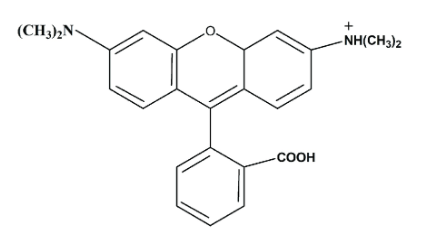
Rhodamine-B: Harmful Water-Soluble Dye
- Nature and Appearance
- Rhodamine-B is a water-soluble chemical compound.
- Initially green in powder form, it transforms into a vibrant fluorescent pink upon contact with water.
- Industrial Usage
- Widely employed in the textile, paper, leather, and paints industries as a coloring agent, contributing to the red and pink spectrum.
- Legal Implications
- According to the Food Safety Standards Act (2006), utilizing Rhodamine-B in the preparation, packaging, importing, selling, or serving food during public events, including weddings, is a punishable offense.
- Toxicity and Health Concerns
- Considered an industrial dye, Rhodamine-B is prohibited in food worldwide due to its toxic nature.
- Regular consumption can lead to damage in cerebellum tissue and the brainstem, affecting motor functioning.
- Oxidative Stress and Health Risks
- Ingesting the chemical may induce oxidative stress on cells and tissues, posing significant health risks.
- When mixed with food products, it becomes particularly hazardous, potentially leading to cancer and tumors over time.
- Legal Consequences
- The use of Rhodamine-B in food items violates legal standards, inviting punitive actions under food safety regulations.
Source: IT
Raisina Dialogue - Edukemy Current Affairs
In News: The upcoming Raisina Dialogue, marking its ninth edition, is scheduled to take place in New Delhi from February 21 to 23.
Raisina Dialogue: Annual Forum on Geopolitics and Geoeconomics
- Overview
- The Raisina Dialogue is an annual conference addressing critical global issues in geopolitics and geoeconomics.
- Venue and Duration
- Initiated in 2016, the conference is held annually in New Delhi, spanning three days.
- Diverse Participation
- Attendees include individuals from political, business, media, and civil society backgrounds.
- Multi-Stakeholder Discussion
- Structured as a multi-stakeholder, cross-sectoral dialogue involving heads of state, cabinet ministers, local government officials, and thought leaders from the private sector, media, and academia.
- Organizers
- Organized by the Observer Research Foundation (ORF) in collaboration with the Ministry of External Affairs, Government of India.
- 2024 Theme
- The theme for the 2024 edition is "Chaturanga: Conflict, Contest, Cooperate, Create."
- Thematic Pillars
- The conference revolves around six thematic pillars explored during the three-day event:
- Tech Frontiers: Regulations & Realities
- Peace with the Planet: Invest & Innovate
- War & Peace: Armouries & Asymmetries
- Decolonizing Multilateralism: Institutions & Inclusion
- The Post 2030 Agenda: People & Progress
- Defending Democracy: Society & Sovereignty
Source: IE
Fiscal Devolution in Panchayati Raj
In News: A recent article highlights the necessity of informing elected representatives and the public about the significance of panchayats attaining self-sufficiency and depending on their own financial resources.
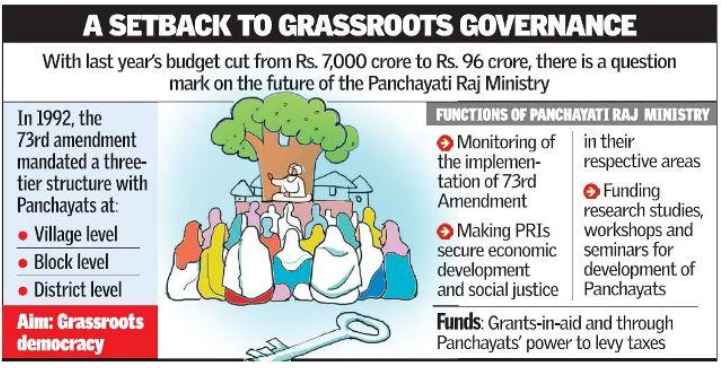
Current Financial Status of Panchayati Raj Institutions (PRIs)
- Revenue Statistics
- In the fiscal year 2022-23, panchayats generated a total revenue of Rs 35,354 crore, with only Rs 737 crore from their own tax revenue.
- Non-tax revenue amounted to Rs 1,494 crore, primarily from interest payments and Panchayati Raj programs.
- Panchayats received Rs 24,699 crore in grants from the Central government and Rs 8,148 crore from State governments.
- Revenue Per Panchayat
- On average, each panchayat earned Rs 21,000 from its own tax revenue and Rs 73,000 from non-tax revenue.
- Grants from the Central government amounted to approximately Rs 17 lakh per panchayat.
- State Revenue Share and Inter-State Disparities
- Panchayats' share in their respective State's own revenue remains minimal.
- Wide variations exist among states regarding average revenue earned per panchayat.
Importance of Panchayats Achieving Self-Sufficiency
- Excessive Reliance on Grants
- Panchayats earn only 1% of the revenue through taxes, with 80% from the Centre and 15% from the States.
- Disparities Across States
- Some States have embraced decentralization, while others lag behind, leading to disparities in revenue collection.
- General Aversion Towards Generating Own Income
- Panchayats are showing less interest in collecting Own Source of Revenue (OSR) due to increased allocations from Central Finance Commissions.
- Impediments Due to Freebie Culture
- A 'freebie culture' in society hampers resource mobilization, with elected representatives reluctant to impose taxes.
Suggestions for Boosting Financial Resources of PRIs
- Expert Committee Report
- State Acts should detail tax and non-tax revenue that can be collected and utilized by panchayats.
- Establishing Conducive Environment
- Panchayats should implement financial regulations, decide on tax and non-tax bases, and diversify revenue sources.
- Diversifying Sources for Non-Tax Revenues
- Non-tax revenue potential includes fees, rent, income from investment sales, and innovative projects.
- Leveraging Local Resources
- Gram sabhas play a role in leveraging local resources for revenue generation, with the authority to impose taxes.
- Fostering Partnerships
- Gram sabhas need to promote entrepreneurship and forge partnerships for effective revenue generation.
- Recommendations of RBI
- Promote greater decentralization, enhance financial autonomy, and ensure transparent budgeting.
- Educating Elected Representatives and Public
- Raise awareness about the significance of revenue generation to minimize dependency on grants.
Related Initiatives
- SVAMITVA Scheme
- Launched to provide a "Record of Rights" to every rural household owner for economic progress.
- e-Gram Swaraj e-Financial Management System
- A simplified work-based accounting application for Panchayati Raj.
- Geo-Tagging of Assets
- A mobile-based solution for capturing photos with Geo-Tags for works with assets as an output.
- Citizen Charter
- Platform to upload Citizen Charter documents, focusing on PRIs' commitment to citizens.
- Revamped Rashtriya Gram Swaraj Abhiyan (2022-23 to 2025-26)
- A scheme to reimagine PRIs as vibrant centers of local self-governance with a focus on sustainable development goals.
|
UPSC Previous Year Questions Prelims (2017) Q. Local self-government can be best explained as an exercise in (a) Federalism Ans: (b) Prelims (2015) Q. The fundamental object of Panchayati Raj system is to ensure which among the following?
Select the correct answer using the code given below (a) 1, 2 and 3 only Ans: (c) Mains (2018) Q1. Assess the importance of the Panchayat system in India as a part of local government. Apart from government grants, what sources can the Panchayats look out for financing developmental projects? Mains (2022) Q2. To what extent, in your opinion, has the decentralisation of power in India changed the governance landscape at the grassroots? Mains (2015) Q3. In absence of a well-educated and organised local level government system,`Panchayats’ and ‘Samitis’ have remained mainly political institutions and not effective instruments of governance. Critically discuss. |
Source: TH
CONSTRUCTION OF SUBSURFACE DAMS - Case Study of the Day
Drought-prone Kadapa in Andhra Pradesh addresses water shortage by constructing subsurface dams using Z sheet piling on River Papagni, leading to effective groundwater utilization, control of fluctuations, and increased borewell yields, ensuring sustainable irrigation in Kharif and Rabi seasons.
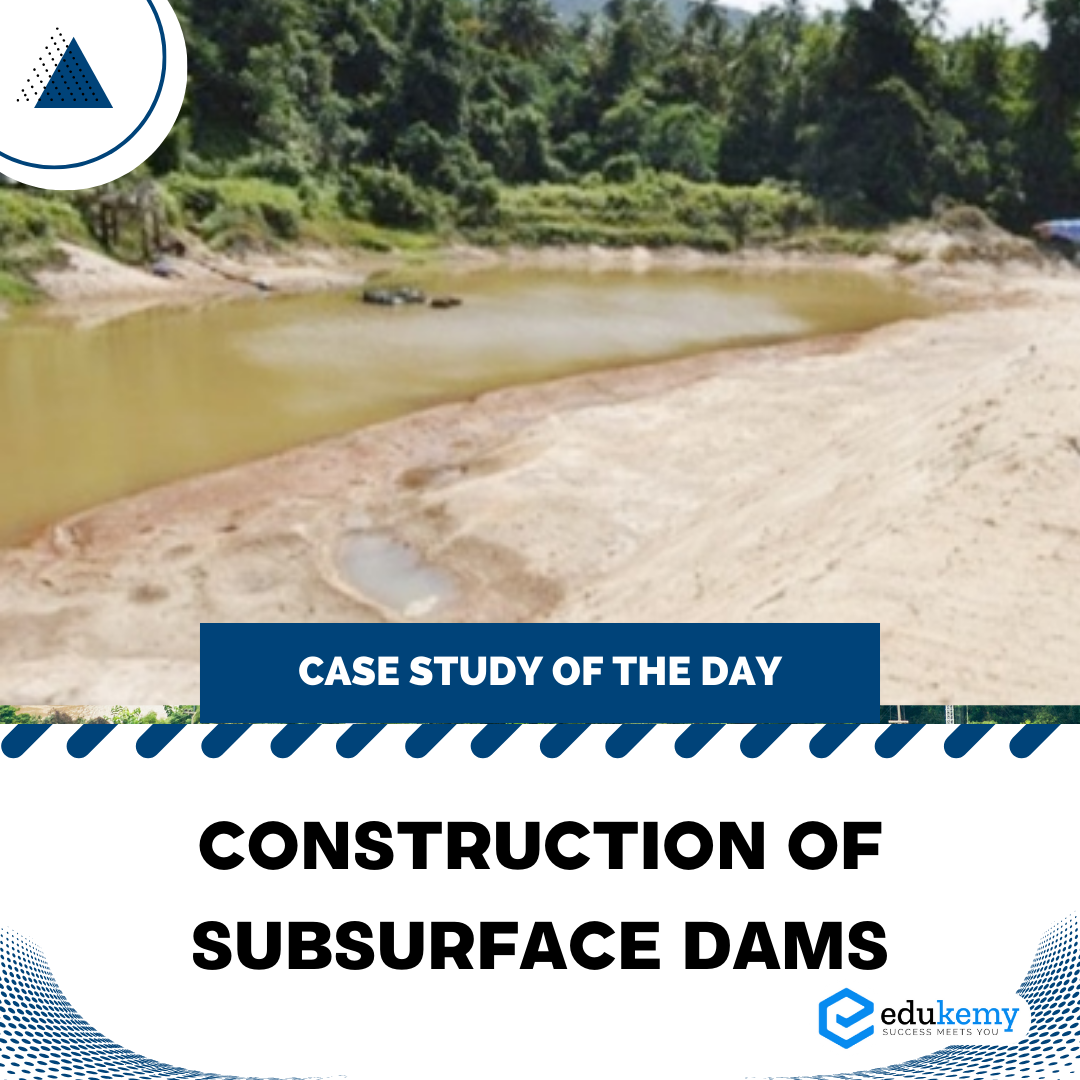
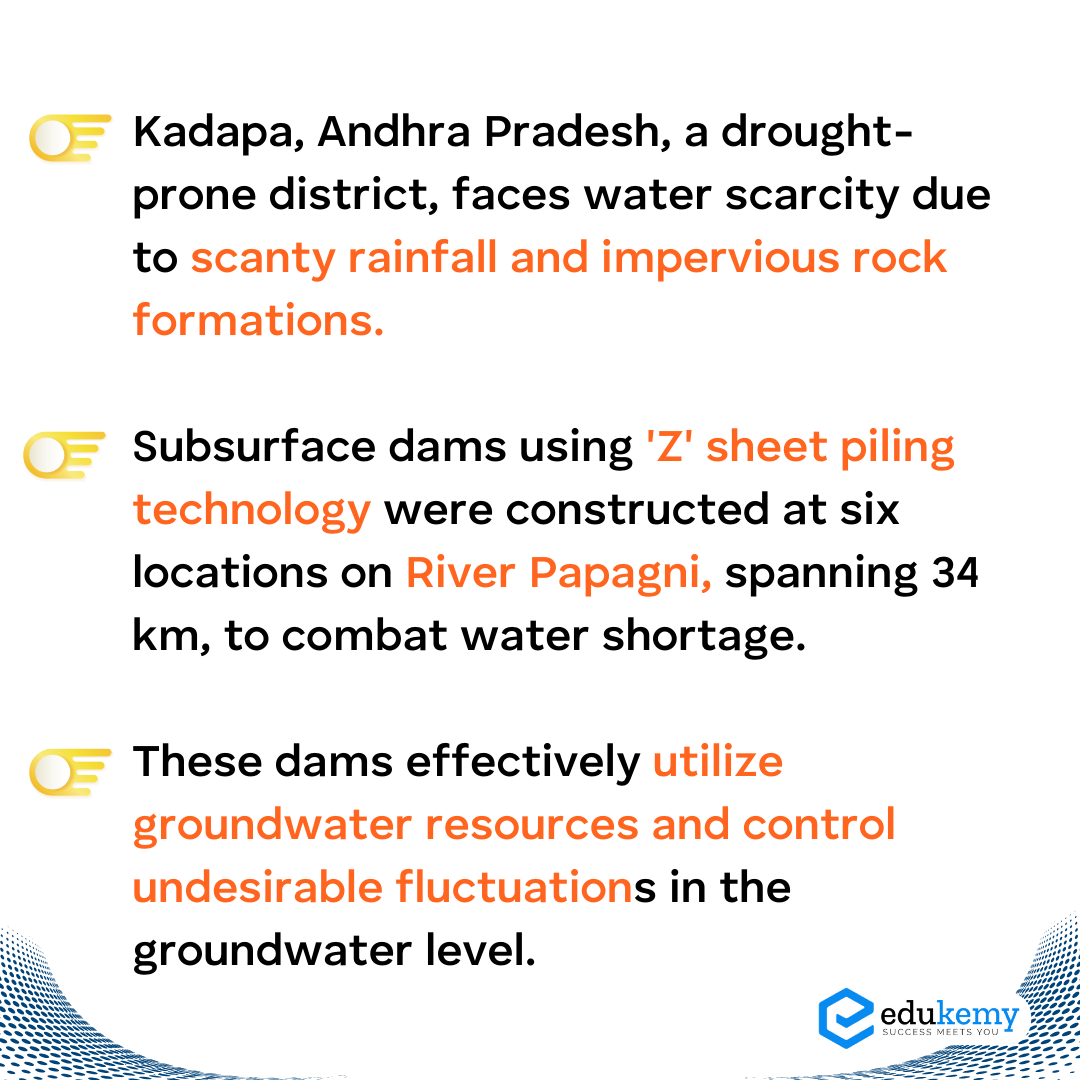

Share the article
Edukemy’s Current Affairs Quiz is published with multiple choice questions for UPSC exams
MCQ
Get Latest Updates on Offers, Event dates, and free Mentorship sessions.

Get in touch with our Expert Academic Counsellors 👋
FAQs
UPSC Daily Current Affairs focuses on learning current events on a daily basis. An aspirant needs to study regular and updated information about current events, news, and relevant topics that are important for UPSC aspirants. It covers national and international affairs, government policies, socio-economic issues, science and technology advancements, and more.
UPSC Daily Current Affairs provides aspirants with a concise and comprehensive overview of the latest happenings and developments across various fields. It helps aspirants stay updated with current affairs and provides them with valuable insights and analysis, which are essential for answering questions in the UPSC examinations. It enhances their knowledge, analytical skills, and ability to connect current affairs with the UPSC syllabus.
UPSC Daily Current Affairs covers a wide range of topics, including politics, economics, science and technology, environment, social issues, governance, international relations, and more. It offers news summaries, in-depth analyses, editorials, opinion pieces, and relevant study materials. It also provides practice questions and quizzes to help aspirants test their understanding of current affairs.
Edukemy's UPSC Daily Current Affairs can be accessed through:
- UPSC Daily Current Affairs can be accessed through Current Affairs tab at the top of the Main Page of Edukemy.
- Edukemy Mobile app: The Daily Current Affairs can also be access through Edukemy Mobile App.
- Social media: Follow Edukemy’s official social media accounts or pages that provide UPSC Daily Current Affairs updates, including Facebook, Twitter, or Telegram channels.



